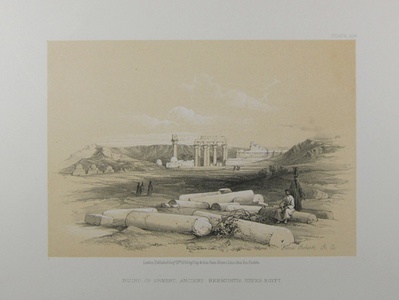| Method | Lithograph with tint stone |
| Artist | after David Roberts |
| Published | London, Published Sepr. 15th. 1856, by Day & Son, Gate Street, Lincoln's Inn Fields |
| Dimensions | Image 124 x 175 mm, Sheet 202 x 290 mm |
| Notes |
Plate 209 from Volume 5 of the small format reprint of Roberts' The Holy Land, Syria, Idumea, Arabia, Egypt & Nubia. A view of the ruins of the ancient city of Hermonthis, near the modern town of Armant, Egypt. The city of Hermonthis, known to the ancient Egyptians as Iuny, was a cult centre for the local Theban war-god, Montu. A cult shrine and temple dedicated to Montu was built by the Late Period pharaoh Nectanebo II, on the site of an earlier shrine dating to the Middle Kingdom. Nectanebo's temple was enlarged during the Ptolemaic era, gaining a birth house and sacred lake under the reign of the famous Cleopatra VII. In the Roman period, two monumental gates were built. The city's cultic connection with Montu was also strengthened by the inclusion of a burial ground for the sacred bulls of the Buchis. Roberts' view of the city shows two colonnades still standing in the ruins of the Temple of Montu, as well as part of the ruinous Pylon of Thutmosis III. Around the site, a number of domed Islamic burial shrines can be seen. In the foreground, a man and women rest amongst the fallen columns of another structure. David Roberts RA (24th October 1796 – 25th November 1864) was a Scottish painter. He is especially known for a prolific series of detailed prints of Egypt and the Near East produced during the 1840s from sketches made during long tours of the region (1838-1840). This work, and his large oil paintings of similar subjects, made him a prominent Orientalist painter. He was elected as a Royal Academician in 1841. The firm of Day & Haghe was one of the most prominent lithographic companies of the nineteenth-century. They were also amongst the foremost pioneers in the evolution of chromolithography. The firm was established in 1823 by William Day, but did not trade under the moniker of Day & Haghe until the arrival of Louis Haghe in 1831. In 1838, Day & Haghe were appointed as Lithographers to the Queen. However, and perhaps owing to the fact that there was never a formal partnership between the two, Haghe left the firm in the 1850's to devote himself to watercolour painting. The firm continued as Day & Son under the guidance of William Day the younger (1823 - 1906) but, as a result of a scandal involving Lajos Kossuth, was forced into liquidation in 1867. Vincent Brookes bought the company in the same year, and would produce the caricatures for Gibson Bowles' Vanity Fair magazine, as well as the illustrations for Cassells's Poultry Book, amongst other commissions. Condition: Light foxing to margins, not affecting image. |
| Framing | unmounted |
| Price | £30.00 |
| Stock ID | 39203 |

